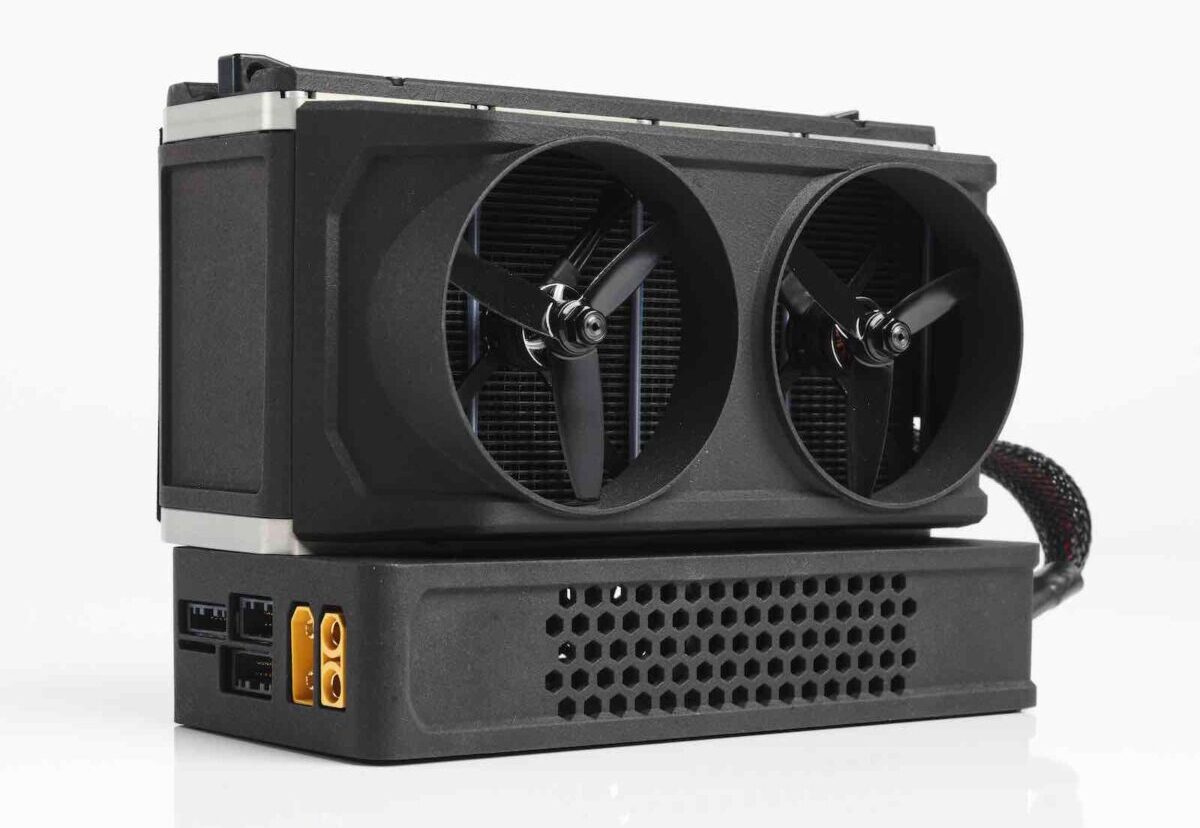- Which components are included in a fuel cell module?
- What is the difference between a fuel cell stack, a fuel cell module and fuel cell system?
- How does a fuel cell work?
- What does a fuel cell system comprise of?
- How are fuel cell stack modules integrated in complete fuel cell systems? Which are the interfaces to other components?
- What is the voltage of a cell in the fuel cell module?
- Which are the key performance criteria of a fuel cell module?
- Which are the preferred use cases of fuel cell modules?
- When used in a fuel cell powered drone which are the criteria that need to be achieved to create an advantage vs. pure battery electric powered drones?
- Which power ranges for fuel cell modules are needed for which use case?
- Which measures are taken to reduce the weight of fuel cell stacks and systems?
- How are fuel cell modules tested?
- Does a fuel cell module need maintenance?
- How long is the lifetime of state-of-the-art fuel cell modules?
Browse fuel cell stack modules from leading suppliers on our marketplace!
Which components are included in a fuel cell module?
Fuel cell modules consist of a PEM fuel cell stack with an enclosure and some sensors and actuators. The fuel cell stack assembly itself is made up of a variety of parts that make up the fuel cell module, namely the auxiliary hardware, such as individual fuel cells and cell assemblies, anodes, cathodes, current collector plates, matrixes, manifolds, instrumentation, mounting, and compression hardware, as well as the stack enclosure vessel.
What is the difference between a fuel cell stack, a fuel cell module and fuel cell system?
A fuel cell stack is the heart of the technology. This is where the electrochemistry occurs, combining hydrogen and oxygen from the air to generate the DC electric current. The stack comprises of layers of cells, end plates, MEAs, gaskets, seals, gas diffusion layers, all without a casing around it.
A fuel cell module is inclusive of the PEM fuel cell stack and the immediate system requirements to manage this fuel cell stack itself – including air and hydrogen delivery systems, hydrogen re-circulation, primary coolant, high and low voltage control systems, and an overall control system.
A fuel cell system includes the fuel cell module plus all balance-of-plant items which can include air delivery (compressor), water, and thermal management modules, high and low voltage circuits, and a control system. Heat exchanger and exhaust modules are typically external to the fuel cell system and, along with a DC: DC converter, are configured specifically to a vehicle powertrain or stationary system layout.
How does a fuel cell work?
Fuel cells work similarly to batteries, however they can produce electricity continuously as long as hydrogen fuel and oxygen are supplied. Unlike batteries, they do not run down or need recharging. A fuel cell works on the principle of electrochemical reactions. By converting chemical energy in the hydrogen fuel into electrical energy, a higher fuel cell stack efficiency is achieved than can be obtained using batteries. A PEM fuel cell stack is a collection of individual cells that have been sandwiched together using bipolar plates (an anode and cathode combined in one). Hydrogen is passed through the anode while oxygen is passed through the cathode from the air. At the anode, hydrogen molecules are split into electrons and protons by a catalyst. Positive particles can pass through the membrane, but negative particles cannot. However, atoms need an equalizing charge and so electrons change the path. At that time, electrons are forced through the circuit and generate electric current. The byproduct of this reaction is water and heat. At the cathode, hydrogen protons, electrons and oxygen combine to produce water molecules.
What does a fuel cell system comprise of?
A fuel cell system comprises a PEM fuel cell stack, a fuel cell stack module, and a balance-of-plant system. The fuel cell stack comprises layers of cells in which an electrochemical reaction takes place, with hydrogen and oxygen from the air combining to generate electricity and water. The fuel cell stack components include bipolar plates, membrane electrode assemblies (MEAs), seals and end plates, and the tensioning system. A stack module includes additional system functionalities to simplify integration into client systems in order to optimize system compatibility, control, and performance. These are normally built into a special media module and include valves, condensate separators for the anode circuit, pressure and temperature sensors, and optional, customer-specific features of the fuel cell stack design.
How are fuel cell stack modules integrated in complete fuel cell systems? Which are the interfaces to other components?
Connection to hydrogen storage via a pressure regulated delivery line is needed, together with thermal and exhaust modules and communications to and via a ‘vehicle’ or other master controller. Other interfaces are needed for low and high voltage connections. A connection to water as byproduct is necessary.

Fuel Cell Module IE-SOAR 800W of Intelligent Energy
What is the voltage of a cell in the fuel cell module?
A membrane electrode assembly (MEA) and two flow-field plates, which deliver between 0.5 and 1V of voltage, make up a single fuel cell (too low for most applications). Therefore, depending on the type of application, multiple cells are connected in series to provide required power.
Which are the key performance criteria of a fuel cell module?
Current density (amps per sq. cm) and stack voltage, with commensurate temperature and water management, are key performance criteria for fuel cell modules. These parameters all contribute to the overall PEM fuel cell power density. The type of cooling, hydrogen fuel quality grade, fuel consumption, peak load management and configuration of the fuel cell are other variables that determine how well the fuel cell module performs.
Which are the preferred use cases of fuel cell modules?
Fuel cell technology has the benefit of being both scalable and modular. Just assemble the cells together to produce the necessary power output.
Heavy-duty motive power systems (auto, rail, marine), stationary power generation, construction equipment and backup power generation are ideal applications for fuel cell technology. With light weighting and system management, fuel cell modules can also be adapted for use in UAV and eVTOL applications.
PEM fuel cell power density is an important factor in the viability of fuel cell powered unmanned aerial vehicles. Due to the modular design, continuous and constant power delivery, this technology is ideally suited for ultra-modern mobility applications, including in aerial vehicles such as a fuel cell powered drone.

Fuel Cell Module IE-SOAR 2.4kW of Intelligent Energy attached to Fuel Cell Drone
When used in a fuel cell powered drone which are the criteria that need to be achieved to create an advantage vs. pure battery electric powered drones?
Fuel cell mass and power density are critical in ensuring high productivity, and longer duty cycle operation (flight time) when compared to pure battery electric options.
Which power ranges for fuel cell modules are needed for which use case?
For current generation UAVs, up to 5kW can already be achieved. For higher power applications such as stationary, automotive, and other motive power (rail, off-road, marine) applications, up to 300kW is more typical. For eVTOL and aero, it is around 1MW+.
Which measures are taken to reduce the weight of fuel cell stacks and systems?
Mass reduction across stacks, enclosures and all balance-of-plant equipment is critical in achieving extended flight times for aero applications. It is also needed as a trade-off to optimise acceleration, cruise and fuel consumption and system lifetime across motive applications.
How are fuel cell modules tested?
Extensive testing takes place at the individual fuel cell component, cell, stack, subsystem, and complete system level. QC and QA tests are used to check the performance of the fuel cell module including for example: leak tests and fluid checks, cell voltage monitoring, cell/stack polarisation and life cycle testing.
Does a fuel cell module need maintenance?
Fuel cells have no moving parts and are likely to be more reliable than combustion engines, however fuel cell systems require maintenance e.g., filters. Stationary fuel cells require relatively little upkeep dependent on local environmental conditions (dust, temperature, etc), which can be remotely monitored, with standard operation and maintenance servicing.
How long is the lifetime of state-of-the-art fuel cell modules?
The lifetimes of current stack modules will vary depending on operating profiles for different applications and can largely be configured through modification or optimization of materials and system management. A high-performance passenger vehicle can be optimised against performance requirements whilst a heavy-duty truck will typically be optimised for lifetime instead. The fuel cell stacks in passenger FCEVs are intended to provide for around 150,000 to 200,000 miles of operation, or the lifespan of the FCEVs.
Content contributed by Intelligent Energy
Intelligent Energy is a fuel cell engineering business built on 30 years of PEM fuel cell development. It is focused on the development and commercialisation of its PEM fuel cell technologies for a range of markets including automotive, stationary power and UAVs. It is headquartered in the UK, with additional operations in the US, Japan, Korea and China.
Last update: 15.1.2023


